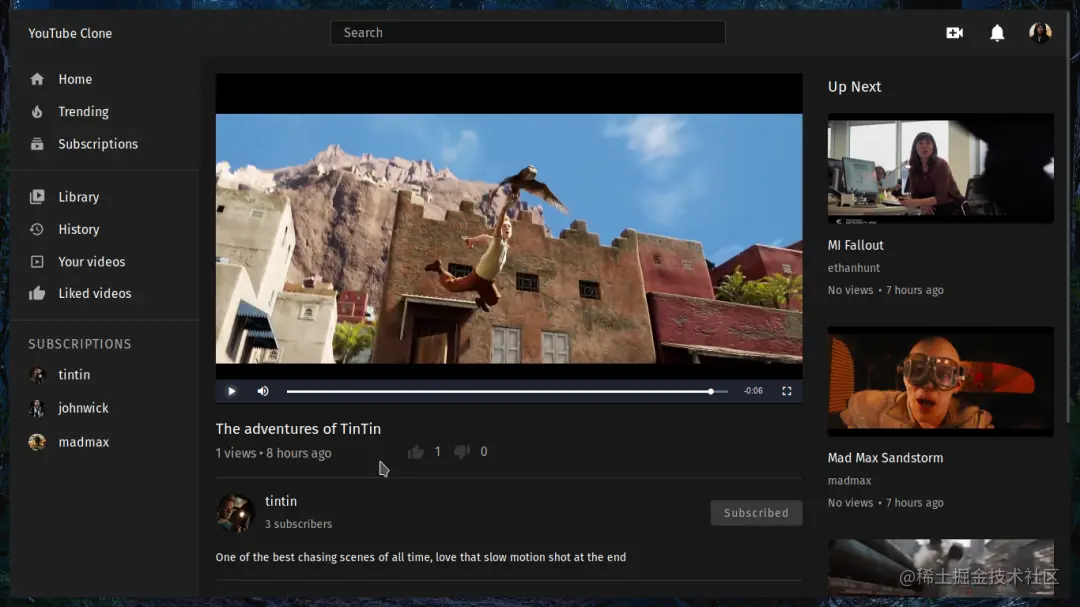This article brings you what is the relationship between react, redux and react-redux? , has certain reference value, friends in need can refer to it, I hope it will be helpful to you.
React
For some small projects, only using React is enough. Props and state can be used for data management. So when do you need to introduce Redux? ? When the data for rendering a component is obtained from the parent component through props, it is usually A --> B, but as the business complexity increases, it may be like this: A --> B -- > C --> D --> E, the data required by E needs to be passed from A through props, and the corresponding E --> A reversely passes the callback. The component BCD does not need these data, but it must be passed through them, which is indeed a bit unpleasant, and the passed props and callbacks will also affect the reuse of the BCD component. Or if sibling components want to share certain data, it is not very convenient to transfer or obtain it. In situations like this, it is necessary to introduce Redux.
Actually A --> B --> C --> D --> E In this case, React can get the data without passing props layer by layer. Just use Context. . The react-redux that will be discussed later uses Context to allow each sub-component to get the data in the store.
Redux
In fact, we just want to find a place to store some shared data. Everyone can get it and modify it, that's all. Is it okay to put it in one all variables? Yes, of course it works, but it is too inelegant and unsafe because it is a global variable that can be accessed and modified by anyone. It may be accidentally overwritten by a friend. If global variables don't work, just use private variables. Private variables cannot be modified easily. Do you immediately think of closures...
Now we need to write such a function, which satisfies:
Storing a data object
The outside world can access this data
The outside world can also modify this data
When the data changes, the subscriber is notified
function createStore(reducer, initialState) {
// currentState就是那个数据
let currentState = initialState;
let listener = () => {};
function getState() {
return currentState;
}
function dispatch(action) {
currentState = reducer(currentState, action); // 更新数据
listener(); // 执行订阅函数
return action;
}
function subscribe(newListener) {
listener = newListener;
// 取消订阅函数
return function unsubscribe() {
listener = () => {};
};
}
return {
getState,
dispatch,
subscribe
};
}
const store = createStore(reducer);
store.getState(); // 获取数据
store.dispatch({type: 'ADD_TODO'}); // 更新数据
store.subscribe(() => {/* update UI */}); // 注册订阅函数
Steps to update the data:
What: What do you want to do--- dispatch(action)
How: How to do it, the result--- reducer(oldState, action) => newState
Then?: Re-execute the subscription function (Such as re-rendering the UI, etc.)
This implements a store and provides a data storage center for external access, modification, etc. This is the main idea of Redux. Therefore, Redux does not have any essential relationship with React. Redux can be used normally in combination with other libraries. It’s just that the data management method of Redux is very consistent with the data-driven view concept of React. The combination of the two makes development very convenient.
Now that we have a safe place to access data, how can we integrate it into React? We can create a window.store = createStore(reducer) when the application is initialized, and then obtain data through store.getState() where needed, update the data through store.dispatch, and subscribe to data changes through store.subscribe. Then perform setState... If you do this in many places, it will be really overwhelming, and it still does not avoid the inelegance of global variables.
React-Redux
Since global variables have many shortcomings, let’s change the idea and integrate the store directly into the top-level props of the React application. As long as each sub-component It is enough to have access to the top-level props, such as this:
<topwrapcomponent> <app></app> </topwrapcomponent>,
React just provides such a hook, Context, and its usage is very simple. You will understand it by taking a look at the official demo. Now that each sub-component can easily access the store, the next step is for the sub-component to take out the data used in the store, modify it, and subscribe to update the UI, etc. Each subcomponent needs to do this again. Obviously, there must be a more convenient way: higher-order components. By encapsulating store.getState(), store.dispatch, and store.subscribe through high-order components, the subcomponents have no awareness of the store. The subcomponents normally use props to obtain data and callbacks to trigger callbacks, which is equivalent to the existence of no store. .
The following is the rough implementation of this high-order component:
function connect(mapStateToProps, mapDispatchToProps) {
return function(WrappedComponent) {
class Connect extends React.Component {
componentDidMount() {
// 组件加载完成后订阅store变化,如果store有变化则更新UI
this.unsubscribe = this.context.store.subscribe(this.handleStoreChange.bind(this));
}
componentWillUnmount() {
// 组件销毁后,取消订阅事件
this.unsubscribe();
}
handleStoreChange() {
// 更新UI
this.forceUpdate();
}
render() {
return (
<wrappedcomponent></wrappedcomponent>
);
}
}
Connect.contextTypes = {
store: PropTypes.object
};
return Connect;
};
}
使用connect的时候,我们知道要写一些样板化的代码,比如mapStateToProps、mapDispatchToProps这两个函数:
const mapStateToProps = state => {
return {
count: state.count
};
};
const mapDispatchToProps = dispatch => {
return {
dispatch
};
};
export default connect(mapStateToProps, mapDispatchToProps)(Child);
// 上述代码执行之后,可以看到connect函数里面的
<wrappedcomponent></wrappedcomponent>
// 就变成了
<wrappedcomponent></wrappedcomponent>
// In this way, the props of the sub-component Child have two additional attributes, count and dispatch
// count can be used to render the UI, and dispatch can be used to trigger callbacks
So, is this OK? OK. Generate a data center store through a closure, and then bind this store to the top-level props of React. The sub-components establish contact with the top-level props.store through HOC, and then obtain data, modify data, and update the UI. Here we mainly talk about how the three are connected together. If you want to know more advanced functions, such as redux middleware, reducer splitting, other parameters of connect, etc., you can take a look at the corresponding source code.
The above is the detailed content of What is the relationship between react, redux and react-redux?. For more information, please follow other related articles on the PHP Chinese website!
 GitHub项目分享:10款点开就能玩的开源在线游戏Mar 24, 2023 pm 07:15 PM
GitHub项目分享:10款点开就能玩的开源在线游戏Mar 24, 2023 pm 07:15 PM本篇文章在GitHub上给大家整理总结10 款开源的在线游戏,点开就能玩的那种,大部分游戏支持手机端玩耍,简直不要太爽!
 github是什么Mar 24, 2023 pm 05:46 PM
github是什么Mar 24, 2023 pm 05:46 PMGitHub是一个面向开源及私有软件项目的托管平台,可以让开发者们在这里托管自己的代码,并进行版本控制。GitHub主打的是开源项目与协作,通过这个平台上的开源项目,开发者们可以查看其他开发者的项目源代码,并进行交流和学习。
 【总结】一些可能导致GitHub不能打开的原因和解决方法Mar 27, 2023 am 11:33 AM
【总结】一些可能导致GitHub不能打开的原因和解决方法Mar 27, 2023 am 11:33 AMGitHub是一个非常受欢迎的版本控制和代码托管平台。然而,有时候我们可能会遭遇到无法访问GitHub的问题。这是因为GitHub是一个全球性的平台,受到地理位置、网络状况、网站设置等因素的影响。本文将介绍一些可能导致GitHub不能打开的原因,以及解决这些问题的方法。
 聊聊github中怎么上传项目和文本文档Mar 27, 2023 am 10:53 AM
聊聊github中怎么上传项目和文本文档Mar 27, 2023 am 10:53 AMGitHub是一个基于Git的代码托管平台,被广泛用于开源社区和企业内部代码管理。在GitHub上可以上传项目和文本文档,但是它所支持的格式和上传方式略有不同。
 【整理分享】7个有趣又实用的开源GitHub项目Nov 30, 2022 pm 06:18 PM
【整理分享】7个有趣又实用的开源GitHub项目Nov 30, 2022 pm 06:18 PM本篇文章给大家整理分享7个有趣又实用的开源项目,这些项目都已经收录到GitHub上的,希望对大家有所帮助!
 github中怎么只下载一个文件夹中的内容Mar 27, 2023 am 10:53 AM
github中怎么只下载一个文件夹中的内容Mar 27, 2023 am 10:53 AMGitHub是一个流行的代码托管平台,用于开发人员协作和版本控制。作为开发人员,您可能需要从其他开发人员的GitHub存储库中只下载特定文件夹的内容。在本文中,我们将演示如何在不下载整个存储库的情况下只下载GitHub存储库中的一个文件夹。
 详解将Github项目部署到服务器上的步骤Mar 27, 2023 am 10:53 AM
详解将Github项目部署到服务器上的步骤Mar 27, 2023 am 10:53 AMGithub是目前全球最大的开源社区,很多程序员都会将自己的代码托管在Github上,借助其方便的版本控制和协作功能。然而,Github上的项目仅仅是代码,要把它部署到服务器上运行,需要一些额外的工作。本文将为大家介绍具体的操作步骤。
 聊聊如何删除GitHub库中的一个文件夹Mar 27, 2023 am 11:33 AM
聊聊如何删除GitHub库中的一个文件夹Mar 27, 2023 am 11:33 AMGitHub是一个非常受欢迎的版本控制系统,它允许用户在互联网上存储和共享自己的代码库。它是程序员的必备工具之一。但是,有时候我们可能需要删除GitHub库中的一个文件夹。本篇文章将介绍如何删除GitHub库中的一个文件夹。


Hot AI Tools

Undresser.AI Undress
AI-powered app for creating realistic nude photos

AI Clothes Remover
Online AI tool for removing clothes from photos.

Undress AI Tool
Undress images for free

Clothoff.io
AI clothes remover

AI Hentai Generator
Generate AI Hentai for free.

Hot Article

Hot Tools

SublimeText3 Chinese version
Chinese version, very easy to use

mPDF
mPDF is a PHP library that can generate PDF files from UTF-8 encoded HTML. The original author, Ian Back, wrote mPDF to output PDF files "on the fly" from his website and handle different languages. It is slower than original scripts like HTML2FPDF and produces larger files when using Unicode fonts, but supports CSS styles etc. and has a lot of enhancements. Supports almost all languages, including RTL (Arabic and Hebrew) and CJK (Chinese, Japanese and Korean). Supports nested block-level elements (such as P, DIV),

SublimeText3 Linux new version
SublimeText3 Linux latest version

MantisBT
Mantis is an easy-to-deploy web-based defect tracking tool designed to aid in product defect tracking. It requires PHP, MySQL and a web server. Check out our demo and hosting services.

SAP NetWeaver Server Adapter for Eclipse
Integrate Eclipse with SAP NetWeaver application server.






